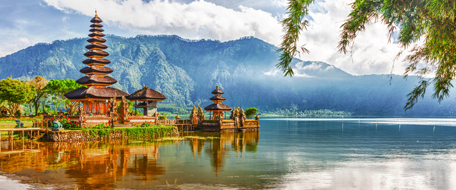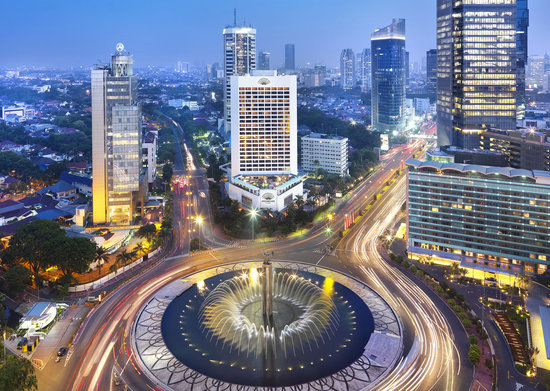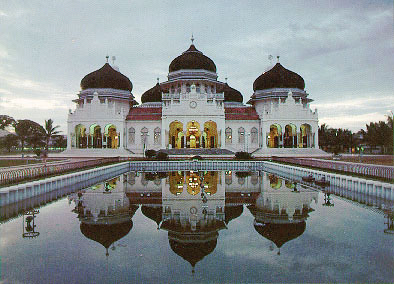When I was in
elementary school, one of my favorite books was The Twenty-One Balloons by William Pène du Bois, published in
1947. It centered around the
eruption of Krakatau, and I was fascinated by the true story of the 1883
Eruption of this island. Years ago while I was a music major at Indiana State
University, I was required to take a World Music course. One of the topics we studied was the
gamalan music of Indonesia. It was some of the most relaxing, beautiful music
I’ve ever heard. It seems like there were little things popping up in my life
that kept me interested in this island country.
The name Indonesia
came from the Greek word Indós,
referring to the Indus River, and the word nésos,
the word for islands. It’s also referred to as the “Indian archipelago.” The
British were the first to call this island chain Indonesia, but when the Dutch
took over this area, it was often referred to as part of the East Indies or
Dutch East Indies.
The country of
Indonesia, the world’s fourth most populous country, is located in the south
Pacific and is spread across thousands of islands. Actually, there are a little
over 17,500 islands, of which only about 6000 of them are inhabited. This
country straddles the Equator, giving it a tropical climate year round. There
are several main islands and island chains in Indonesia including many that are
well known: Sumatra, Java, Bali, Papua, Maluku Islands, Sulawesi, and
Kalimantan (which is actually on the island of Borneo). It shares a border with
Malaysia, Papua New Guinea, and East Timor (or Timor Leste), but it is also
close to the islands of the Andaman and Nicobar Islands (India), Christmas
Island (Australia), the Cocos (Keeling) Islands (Australia), the Philippines,
and Australia as well. Indonesia has one of the most diverse flora and fauna in
the entire world. The islands are essentially the tops of underwater mountains
and volcanoes; likewise, this area is highly susceptible to earthquakes and
tsunamis as well.
 |
| Bali |
The Indonesian
islands have shown evidence that it has been inhabited for nearly 45,000 years.
Soon people learned how to cultivate rice here, and soon religions like
Buddhism, Hinduism, and Islam began to spread throughout the island chain.
Muslim traders had been doing business with the native Indonesians for
centuries before the Europeans got wind of the spices produced in the islands.
The Portuguese were the first Europeans to regularly visit the islands,
followed by the Dutch and the British. The Dutch founded the Dutch East India
Company, which controlled the spice trade industry in what they called the
Dutch East Indies. Even after the Dutch East India Company filed bankruptcy and
dissolved, the Dutch government stayed in Indonesia. During WWII, the Japanese
occupied the island nation. After
the war was over and the Japanese retreated from the island, the Dutch tried to
take it back, but they were met with contempt and conflict from the Indonesian
people. Indonesia was granted its independence in December of 1949. Sukarno was
the first president of the country (apparently it is a common tradition in
Javanese to only have one name). He slowly turned the country from a democratic
society to one with an authoritarian government. A 1965 coup put General
Suharto in control of the country; however, it was still more of the same
corruption that they had earlier. Financial and political struggles eventually
led to Suharto stepping down and East Timor breaking off to become its own
country. However, the country is
on a general slow upswing financially and politically (although there are
disruptions here and there).
Jakarta is the
capital of Indonesia. Situated on the island of Java, Jakarta is the largest
city in the country – and in fact, the Jakarta urban area is the second largest
urban area in the world. It’s considered a global city and modern in every
sense (even though it doesn’t have a high-speed rail system yet due to budget
contraints). The city is home to numerous museums, culinary traditions (both
haute-cuisine and traditional), media center, government center, banking and
financial center, luxury shopping and local markets, music and theatre, and
sports arenas.
Traditionally,
agriculture has been one of the main economic drivers. Indonesia went through periods
of economic instability and was hit hard during the financial crisis in Asia
during the late 1990s as well as the numerous times of political instability.
Today, there are many manufacturing companies that bring a lot of revenue to
the country in the form of exports, and the country receives quite a bit of
foreign investments as well, especially in export manufacturing companies. And
of course, its oil reserves used to be fairly significant, and they were once
the only OPEC member in Southeast Asia. (They left the organization in 2008).
Indonesia is a
multi-ethnic country with many religions. Although their constitution does state
religious freedom, the country officially only recognizes six religions (so, I
suppose you’re free to practice any religion you want as long as it’s one of
these six): Hinduism, Buddhism, Protestantism, Roman Catholicism, Islam, and
Confucianism. Indonesia has the largest Muslim population in the world. The government
requires its people to prescribe to one of these six religions, regardless of
what you actually believe, and it’s also against the law to marry someone with
another religion, unless one person converts to the other’s religion.
Indonesia has more than
700 languages spoken among its islands. The official language is Indonesian,
sometimes called Bahasa Indonesia, which is closely related to Malay (or Bahasa
Melayu). Indonesian is the language in which education is taught in and
official documents are written in, and essentially everyone uses Indonesian as
a lingua franca. However, most people speak one other language; Javanese is the
most spoken, followed by Sundanese and Madurese.
Although Dutch was
spoken here at one time, there are very few people who can speak Dutch today.
There are actually a few codes of the law that are written in Dutch, so some
people studying law find it advantageous to learn Dutch.
Indonesia is quite
a culinary country. The big names
in world cuisine TV shows almost always make a stop in Indonesia. One odd thing
is that Indonesia exports nearly 3000 lbs of frog legs to France every year.
(When I was a kid, I had no idea frog legs had bones in them. Frogs are
squishy, why would they have bones? My mind wasn’t nearly as developed at age
12 as it is now apparently.) Indonesia is also known for the kopi luwak, the
world’s most expensive coffee.
See, someone – how they figured this out is beyond me – thought to feed coffee
beans to this cat-like animal called an Asian palm civit. When it poops out the
coffee beans, it’s collected, washed, then made into coffee. It sounds
absolutely, diabolically disgusting to me, but I’ve read that this unorthodox
process takes out a lot of the bitterness of the coffee beans. I guess I’ll
just have to take their word on it. I’ll just take my regular Sumatran blend.
Although Indonesians have borrowed from many cultures in their cuisines, their
customs, and their languages, there is one word we’ve borrowed from Indonesian
into English: the phrase “run amok.” Originally from the word mengamuk, it means “to make a furious
and desperate charge.” Today, it means closer to “behave uncontrollably and
disruptively.” But there will be
no running amok once I serve the Indonesian dishes I picked out. I super can’t
wait for this.
Up next: art and
literature







No comments:
Post a Comment